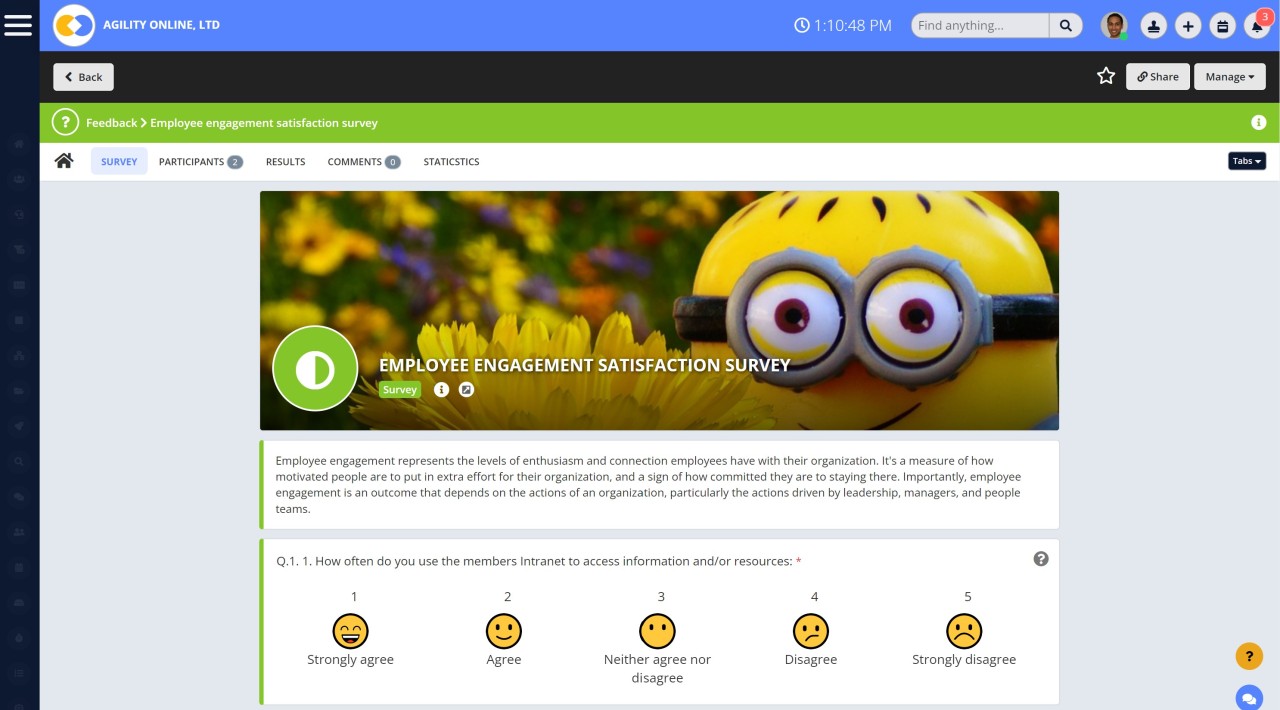Insight Blog
Agility’s perspectives on transforming the employee's experience throughout remote transformation using connected enterprise tools.
15 minutes reading time
(2967 words)
Most crucial leadership audit questions: 2022 Questions to ask
So what are the Most crucial leadership audit questions: 2022 Questions to ask? Some of the greatest leaders also take a moment to assess their skills and activity using a leadership audit.
Owning a company or leading a team comes with its share of responsibilities and difficulties. In addition to keeping an eye on the health of the company as a whole, securing new contracts, and completing your own tasks, a manager is responsible for ensuring that his or her team has access to the resources they need to fulfill their duties effectively.
Maintaining a satisfactory equilibrium can be challenging, but if you've established a habit that works, you'll likely remain with it. However, in today's cutthroat business environment, it's more important than ever to conduct periodic leadership audits and assess your own managerial effectiveness. The morale and output of your staff will increase, and your business will gain an edge over rivals as a result.
Why is it essential to perform a leadership audit?
Due to the ongoing and often drastic change we all encounter, you may discover that strategies that were effective in the past are no longer useful. Perhaps there have been shifts in company size, personnel, you personally, and the health care system. Therefore, it's imperative that you adjust your leadership style.
It's crucial to have a mechanism to check how well you're leading, even though it can be isolating at the top. Employees may be in the dark about any particularly difficult decisions you have to make. Given that every one of us has our unique set of strengths and weaknesses as leaders, it's crucial that we don't rely solely on a self-reflective approach to identifying and addressing these issues.
The best way to improve as a leader is to foster an environment where employees feel comfortable sharing ideas and offering feedback. You may make these adjustments and stay on track by regularly assessing your attention, actions, ideas, words, and motivation.
What is the best way to conduct a leadership audit?
There are several ways to conduct a leadership audit, and the best approach will depend on the specific needs and goals of the organization. Here are some steps that can be followed when conducting a leadership audit:
- Define the scope and objectives of the audit: Make a list of what aspects of leadership the audit will focus on and what specific goals or outcomes the audit is intended to achieve.
- Identify key stakeholders: Again make a list of who will be involved in the audit process, including employees, leaders, and external experts or consultants.
- Gather data and information: Collect as much data and information about the leadership team and the organization's leadership practices, using a variety of methods such as surveys, interviews, focus groups, and review of documents and records.
- Analyze and interpret the data: Review and analyze the data collected to identify patterns, trends, and areas of strength and weakness within the organization's leadership practices.
- Develop recommendations and a plan of action: Based on the findings of the audit, develop recommendations for improvement and a plan of action to address any identified areas of concern.
- Communicate the findings and implement the plan: Share the findings of the audit and the recommended plan of action with key stakeholders and work with the leadership team to implement the recommendations.
It is important to involve a diverse group of stakeholders in the audit process in order to get a well-rounded and comprehensive view of the organization's leadership practices. It is also important to ensure that the audit is conducted in a transparent and objective manner and that the findings and recommendations are communicated clearly and effectively.
What are the 10 Important leadership audit questions to ask?
Question 1: What is the vision and mission of the organization, and how is it communicated and pursued by leadership?
The vision and mission of an organization provide direction and purpose for the organization's activities and goals. They help to define the organization's purpose and the impact it aims to have on its stakeholders.
Asking about the vision and mission of the organization can help to assess whether the leadership team is aligning its actions and decision-making with the organization's values and objectives. It can also help to determine whether the leadership team is effectively communicating the organization's purpose to its employees and stakeholders, and whether it is actively working towards achieving its goals.
In a leadership audit, this question can help to evaluate whether the leadership team is effectively guiding the organization towards its desired future state and whether it is fostering a culture that supports the achievement of the organization's goals. It can also help to identify any discrepancies or gaps between the organization's stated values and mission and the actions and behaviors of its leaders.
Question 2: What is the leadership style of the organization, and how does it align with the culture and values of the organization?
The leadership style of an organization refers to the way in which leaders make decisions, communicate with their team, and provide guidance and direction. Some common leadership styles include autocratic, democratic, transformational, and servant leadership.
Write the question around leadership style of the organization can help to assess whether the leadership team's approach is effective and aligned with the culture and values of the organization. For example, if the organization values collaboration and teamwork, a more democratic leadership style that encourages input and participation from team members may be more effective.
On the other hand, if the organization values efficiency and speed, an autocratic leadership style that relies on a single leader making decisions may be more appropriate.
Question 3: How is decision-making delegated and shared within the leadership team and throughout the organization?
Decision-making is an essential part of leadership and involves choosing the best course of action based on available information and resources. It is important for leaders to delegate decision-making appropriately and to encourage shared decision-making within the organization in order to foster a sense of ownership and empowerment among employees.
Prepare questions about the decision-making process within the leadership team and throughout the organization can help to assess whether the leadership team is effectively sharing responsibility and decision-making power with others. It can also help to determine whether the leadership team is effectively communicating its decision-making process and whether it is fostering an environment that encourages input and participation from all team members.
It can also help to identify any potential bottlenecks or barriers to decision-making that may need to be addressed in order to improve the effectiveness of the leadership team.
Question 4: How is performance evaluated and feedback provided to leaders and employees?
Performance evaluation and feedback are important tools for leaders to assess the effectiveness of their team and to identify areas for improvement. Providing regular, constructive feedback can help to improve employee performance, increase motivation, and foster a sense of ownership and accountability within the organization.
Performance is evaluated and feedback is provided can help to assess whether the leadership team is effectively using these tools to support the development and growth of its team members. It can also help to determine whether the leadership team is adopting a supportive and growth-oriented approach to feedback and whether it is providing regular opportunities for employees to receive feedback and support.
Question 5: How is diversity, equity, and inclusion incorporated into the leadership and decision-making processes?
Diversity, equity, and inclusion (DEI) are important values that should be incorporated into all aspects of an organization, including leadership and decision-making. A diverse and inclusive leadership team and decision-making process can help to foster a more innovative and effective organization, as it can bring a variety of perspectives and experiences to the table.
Asking about how DEI is incorporated into the leadership and decision-making processes can help to assess whether the leadership team is actively promoting diversity and inclusivity within the organization and whether it is making an effort to ensure that all voices are heard and represented in decision-making. It can also help to determine whether the leadership team is adopting a proactive and inclusive approach to DEI and whether it is taking steps to address any potential biases or barriers to diversity and inclusivity within the organization.
Promoting DEI within the organization and whether it is fostering a culture of inclusivity and respect. It can also help to identify any potential gaps or weaknesses in the DEI efforts of the leadership team, which may need to be addressed in order to improve the effectiveness of the leadership team.
Question 6: How is communication and transparency promoted within the organization, and how are concerns and conflicts addressed?
Effective communication and transparency are important for building trust and fostering a positive work environment within an organization. It is important for leaders to promote open and honest communication and to be transparent about decisions and actions taken within the organization.
Asking about how communication and transparency are promoted within the organization, and how concerns and conflicts are addressed, can help to assess whether the leadership team is effectively managing the flow of information within the organization and whether it is fostering an open and transparent work environment. It can also help to determine whether the leadership team is adopting a proactive and inclusive approach to addressing concerns and conflicts and whether it is taking steps to resolve any issues that may arise.
Question 7: How are leaders held accountable for their actions and the outcomes of their decisions?
Holding leaders accountable for their actions and the outcomes of their decisions is an important aspect of effective leadership. It helps to ensure that leaders are making decisions that are in the best interests of the organization and that they are taking responsibility for the consequences of their actions.
Are leaders held accountable, this can help to assess whether the leadership team is adopting a proactive and transparent approach to accountability and whether it is taking steps to address any issues or concerns that may arise. It can also help to determine whether the leadership team is effectively managing the consequences of its decisions and whether it is taking steps to learn from any mistakes that may be made.
Evaluate whether the leadership team is effectively managing accountability within the organization and whether it is fostering a culture of responsibility and integrity. It can also help to identify any potential gaps or weaknesses in the leadership team's approach to accountability, which may need to be addressed in order to improve the effectiveness of the leadership team.
Question 8: How is leadership development and succession planning supported within the organization?
Leadership development and succession planning are important tools for ensuring that the organization has a strong and capable leadership team in place to meet the needs of the organization now and in the future. Providing opportunities for leadership development and supporting the succession planning process can help to foster a culture of continuous learning and development within the organization.
Organisation supports this vision through a range of activities including mentor-mentee programmes and traineeships for those wishing to develop their leadership skills. We also run workshops to equip our workforce with the necessary skills and experience for successful succession planning within the organisation. In addition, our executive team review the current pipeline of talent on a regular basis and set career pathways for all team members to ensure they have the opportunity to rise through the ranks, while adding value to both themselves and the organisation.
Question 9: How is risk management and crisis management addressed by leadership?
Leadership development and succession planning are important tools for ensuring that the organization has a strong and capable leadership team in place to meet the needs of the organization now and in the future. Providing opportunities for leadership development and supporting the succession planning process can help to foster a culture of continuous learning and development within the organization.
Crisis management, on the other hand, is a reactive process that addresses sudden changes and must be addressed quickly. Leaders must make sure they are utilizing resources properly, setting up safeguards and processes to enable quick responses in order to contain or reduce any potential impact. Leaders should establish procedures for monitoring events as they occur, empowering employees to respond swiftly while ensuring everyone remains calm during these tumultuous times. By creating plans of action that reflect the values and goals of the organization, leaders can help ensure appropriate decisions are made while minimizing risk during both regular operations and emergencies.
Question 10: How is the organization adapting to change and pursuing continuous improvement?
The ability to adapt to change and pursue continuous improvement is essential for the long-term success of any organization. It allows the organization to respond to new challenges and opportunities, and to continuously improve its operations and processes.
Asking about how the organization is adapting to change and pursuing continuous improvement can help to assess whether the leadership team is adopting a proactive and forward-thinking approach to managing change and improvement.
9 Leadership Assessment Tools You Need To Try In 2022
Here are nine leadership assessment tools that organizations can consider using in 2022:
- AgilityPortal: The AgilityPortal survey tool allows organizations to conduct surveys and assessments to measure the agile practices and behaviors of their teams. It provides a variety of templates and questions that can be customized to fit the specific needs of the organization. The tool also includes a dashboard that allows organizations to analyze and interpret the survey results and to identify areas for improvement.
- The Leadership Circle Profile: This assessment tool measures leadership effectiveness and helps leaders to identify their strengths and areas for improvement. It is based on the Leadership Circle model, which outlines the behaviors and skills that are necessary for effective leadership.
- The Leadership Styles Inventory: This assessment tool measures an individual's preferred leadership style and helps leaders to understand how their style may impact their effectiveness as a leader.
- The Emotional Intelligence Quotient (EQ) Assessment: This assessment measures an individual's emotional intelligence, which is the ability to recognize and manage one's own emotions and the emotions of others. It can help leaders to develop the skills needed to effectively communicate and build relationships with their team.
- The DiSC Personality Profile: This assessment tool measures an individual's personality and communication style, and can help leaders to understand how their style may impact their interactions with others.
- The Multifactor Leadership Questionnaire (MLQ): This assessment tool measures leadership effectiveness and helps leaders to identify their strengths and areas for improvement. It is based on the Transformational Leadership model, which outlines the behaviors and skills that are necessary for effective leadership.
- The Myers-Briggs Type Indicator (MBTI): This assessment tool measures an individual's personality and communication style, and can help leaders to understand how their style may impact their interactions with others.
- The 360-Degree Leadership Assessment: This assessment tool involves collecting feedback from a variety of sources, including an individual's team members, peers, and superiors. It helps leaders to understand their strengths and areas for improvement from multiple perspectives.
- The Leadership Legacy Assessment: This assessment tool helps leaders to understand their legacy and the impact they have on others. It helps leaders to identify their strengths and areas for improvement and to develop a plan for leaving a positive legacy.
- The Leadership Practices Inventory (LPI): This assessment tool measures an individual's leadership effectiveness and helps leaders to identify their strengths and areas for improvement. It is based on the Five Practices of Exemplary Leadership model, which outlines the behaviors and skills that are necessary for effective leadership.
Regenerate response
What leadership audit challenges can you face?
Failure to acknowledge achievements
If the team's victories aren't recognized, it could lose its momentum and power. Leaders can be prone to jumping from one project to the next with little regard for the quality of their work. Leaders who reflect on the audit's positive aspects and reward employees for their efforts prepare them for future success.
Not giving others a chance to shine
Most auditing managers and directors got there by first shining as auditors. When problems emerge, they may lapse into old habits, such as taking control of the conversation. Internal auditors with less experience require a platform to showcase their work, leeway to test out novel approaches, and hands-on training opportunities.
Not setting clear expectations
Establish measurable goals, and give your staff the freedom to achieve them. Properly educated team members may be trusted with responsibility and should be given the same respect by their superiors.
Micromanagement is a stress-inducing and ineffective leadership strategy that will become increasingly unnecessary as your team matures and demonstrates its worth via performance. After a certain degree of trust has been developed, your team will be able to complete tasks without constant supervision, freeing up the audit leader to focus on other value-added tasks.
Not meeting the deadlines
In the workplace, deadlines are a fact of life, and there will inevitably be occasions when the team is unable to successfully fulfill the said deadline. Leaders who actively listen to their teams and put faith in their knowledge and abilities are more likely to succeed. Pay close attention when anyone on your team mentions a deadline. They'll have to work too much, leading to burnout if nothing is done. Keeping the enthusiasm of hardworking teams up requires them to feel heard.
Wrapping up
The time spent on an audit is always well spent due to the wealth of knowledge and understanding it provides. Every leader's review should include a leadership audit in addition to any other audits you may perform. Moreover, you can ask the questions mentioned above for a better leadership audit.
Categories
Blog
(2576)
Business Management
(315)
Employee Engagement
(204)
Digital Transformation
(171)
Intranets
(119)
Growth
(116)
Remote Work
(61)
Sales
(48)
Collaboration
(37)
Culture
(29)
Project management
(29)
Customer Experience
(26)
Knowledge Management
(21)
Leadership
(20)
Comparisons
(5)
Ready to learn more? 👍
One platform to optimize, manage and track all of your teams. Your new digital workplace is a click away. 🚀
Free for 14 days, no credit card required.
















